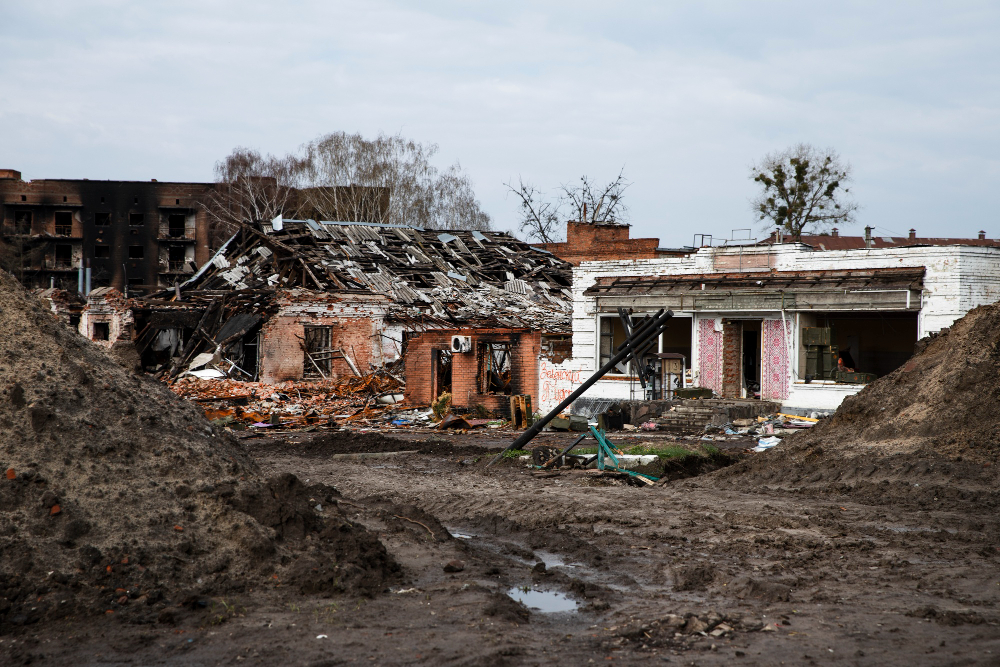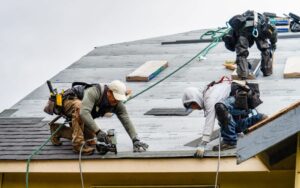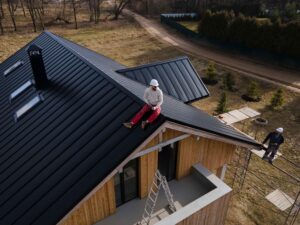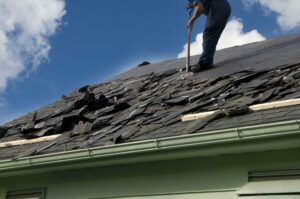Storm damage to your roof includes visible signs like missing or broken shingles, puncture wounds from hail impacts, and leaks that jeopardize structural integrity. Intense winds can dislodge shingles, while heavy rain exacerbates these issues, leading to further deterioration. Look for granule loss in gutters and rusted flashing around chimneys. Documenting these findings is essential for insurance claims. By evaluating your roof’s condition, you can uncover deeper issues that could be affecting your home’s safety.
Types of Storms That Cause Roof Damage
When severe weather strikes, it can wreak havoc on your roof, and understanding the types of storms that cause this damage is essential for homeowners. Hurricanes, known for their intense winds and heavy rainfall, often lead to significant hurricane damage. The force of the wind can lift shingles, create leaks, and even cause structural failure. On the other hand, tornadoes can deliver devastating impacts with their concentrated, high-velocity winds. A tornado’s swirling nature can rip entire roofs off, leaving homes vulnerable to further weather exposure. Both storm types can compromise your roof’s integrity, making it vital to assess potential risks in your area. Knowing these threats helps you prepare and protect your property from severe weather conditions effectively.
Common Signs of Roof Storm Damage
Identifying storm damage to your roof quickly can save you from costly repairs down the line. Start with a thorough roof inspection following a storm. Look for missing or broken shingles, as these expose your roof to further damage. Check for granule loss in the gutters, which indicates shingle deterioration. Pay attention to any visible leaks in your attic or ceiling—these can indicate underlying issues. Additionally, examine the flashing around chimneys and vents for signs of damage or rust. After your inspection, conduct a damage assessment to determine if you need professional help. Document your findings with photos; this can aid in insurance claims if necessary. Being proactive now can extend your roof’s lifespan considerably.
Impact of Wind on Roofing Materials
As strong winds whip through your area, they can exert tremendous pressure on roofing materials, leading to potential damage that might not be immediately apparent. Wind speed plays a vital role; when it surpasses 50 mph, it can lift shingles, dislodge tiles, or even create gaps in your roofing system. Asphalt shingles are particularly vulnerable, as their adhesive can weaken, allowing wind to peel them away. Metal roofing, while more resilient, can still suffer from bending or detachment at high speeds. Even under lower wind conditions, debris can strike your roof, causing dents or punctures. Regular inspections after storms are essential to identify these hidden threats and guarantee your roofing materials remain intact and functional.
Hail Damage: Recognizing the Signs
After facing the threat of wind damage, homeowners should also be vigilant about the potential impact of hail on their roofs. Hailstone impacts can leave visible marks on shingles, resembling small dents or bruises. Check for granule loss, as this can expose the underlying material to further damage. Look for cracks or fissures in the shingles, which could compromise your roof’s integrity. Pay attention to any debris in your gutters, as it may indicate hail-related dislodgment. If you spot these signs, it’s essential to explore repair solutions promptly. Whether it’s patching up minor damage or replacing entire sections, addressing hail damage early can save you from costly repairs down the line. Stay proactive to maintain your roof’s lifespan.
Water Damage: Leaks and Structural Issues
Water damage can wreak havoc on your roof, leading to leaks and serious structural issues if not addressed quickly. When water intrusion occurs, it can penetrate through weak points in your roofing materials, such as damaged shingles or flashing. As water seeps in, it creates an environment ripe for mold growth, which can compromise indoor air quality and worsen your health. Additionally, persistent moisture can lead to structural weakness, undermining the integrity of your roof and possibly causing sagging or collapse. It’s important to inspect your roof regularly, especially after storms, to catch any signs of water damage early. If you find leaks or water stains, it’s time to call a professional to assess and repair the damage before it escalates.
Impact of Falling Debris on Roofs
When severe storms roll through, the risk of falling debris becomes a significant concern for homeowners. Various debris types, such as branches, shingles, or even larger objects like patio furniture, can collide with your roof, causing damage. The impact on different roof materials varies; for instance, asphalt shingles may crack or lift, while metal roofs can dent or warp. Tile roofs are particularly susceptible to breakage from heavy debris. It’s essential to assess any immediate damage after a storm, as compromised roofs can lead to leaks or structural issues. Regular maintenance and inspections can help identify vulnerabilities in your roofing system, ensuring you’re better prepared for the next storm and minimizing potential repair costs.
Long-Term Effects of Storm Damage
Although storm damage may seem like a temporary issue, its long-term effects can profoundly impact your home’s integrity and safety. When you neglect repairs, underlying issues like leaks and mold can develop, compromising the structural integrity of your roof. Over time, moisture can weaken roofing materials, leading to extensive long-term repairs that could have been avoided. Additionally, unresolved damage may cause issues with insulation and energy efficiency, increasing your utility bills. As the roof deteriorates, it can also affect other elements of your home, such as walls and ceilings. By addressing storm damage promptly, you can safeguard your home against these long-term consequences, ensuring it remains a safe and secure environment for you and your family.
Importance of Timely Roof Inspections
Neglecting storm damage can lead to hidden problems, making timely roof inspections essential for maintaining your home’s safety and integrity. Regular roof maintenance is vital, as it allows you to catch issues early, like missing shingles or water leaks, that can escalate into costly repairs. Aim for an inspection frequency of at least twice a year, ideally after severe weather events. During these inspections, pay close attention to flashing, gutters, and seams, as they are common weak points. You’re not just protecting your roof; you’re safeguarding the entire structure of your home. By prioritizing these inspections, you can guarantee your roof remains resilient against future storms, ultimately extending its lifespan and preserving your investment.
Navigating Insurance Claims for Roof Damage
How can you effectively navigate the often complex process of filing an insurance claim for roof damage? Start by reviewing your insurance policy to understand coverage specifics and exclusions. Document all damage with clear photographs and detailed notes, as this evidence will be essential during the claim process. Next, contact your insurer promptly to file your claim, providing all necessary documentation. Be prepared to meet with an adjuster who’ll assess the damage; their report will greatly influence your claim’s outcome. Stay organized by keeping records of all communications and following up persistently. Finally, if your claim is denied or underpaid, don’t hesitate to appeal or consult a public adjuster for assistance. This proactive approach can help guarantee you receive the compensation you deserve.
Preventative Measures to Protect Your Roof
When it comes to protecting your roof, being proactive can save you from costly repairs down the line. Regular roof maintenance is essential; inspect your roof at least twice a year for signs of wear and tear. Look for missing shingles, algae growth, or cracked flashing. Implementing effective weatherproofing techniques, such as sealing joints and applying waterproof coatings, can markedly enhance your roof’s resilience against storms. Confirm gutters and downspouts are clear to prevent water damage. Additionally, consider upgrading to impact-resistant roofing materials if you live in a storm-prone area. By investing time and resources into preventative measures, you’ll not only extend your roof’s lifespan but also safeguard your home from the perils of severe weather.
What Is Considered Storm Damage to a Roof?
storm-damage roofs
roof damage
roof storm
storm damage
roofing
roof
metal roof
roofing shingles
roofer
roofs
roof shingles
roofing material
cool roof
slate roof
pitched roof
tile roofing
wind storm
flat roofs
storm
storms
wind storms
damages
debris
shingles
asphalt shingles
severe weather
ice storm
chimneys
hailstorms
hailstorm
weather conditions
ice storms
windstorm
weathering
rainstorms
skylights
weather
ceilings
skylight
wind
chimney
winds
ceiling
attic
shingle
leak
ventilation
tiles
leaks
what is considered storm damage to a roof?
roof damage isn
roof damage
storm-battered roofs
storm damage
hail damage roof
storm damage presents
roofing
roof doesn
roofing system
wind damage
roof repair
composition-shingled roofs
roof needs repair
roof components
new roof
asphalt-shingled roof
metal roof don
common roof materials
entire roof
roof material
ice storm damage
hailstorm damage
wood-shingled roofs
roof color
damage
structural damage
severe damage
expensive roof
roofcrafters
hail damage
challenging impacts storms
professional roofer
additional damage
roofing contractor
significant wind storm
tile roofs
strong wind storm
severe storms
torn shingles
obvious damage
wood roofs
roof age
storm
interior damage repairs
interior water damage
flat roofs don
professional roofing contractor
ridge shingles
irreplaceable damage
ice-damaged one
hail damages
minor damage
cracked shingles
reputable roofing company
severe weather hits
damages
high winds
strong winds differs
heavy winds
shingle tearing
modern asphalt shingles
deterioration
series shingles
few shingles
protective layer
exterior
impacts
strong winds
weather
gutter damage
collapse
heavy rainfall
craters
frequent ice storms
moderate winds
cracks
buildings
shingle color
repairs
ground
protection
broken
total protection





